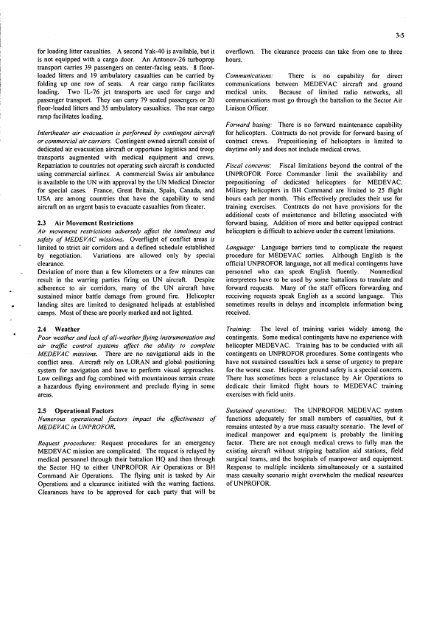Recent Issues and Advances in Aeromedical Evacuation (MEDEVAC)
Recent Issues and Advances in Aeromedical Evacuation (MEDEVAC)
Recent Issues and Advances in Aeromedical Evacuation (MEDEVAC)
You also want an ePaper? Increase the reach of your titles
YUMPU automatically turns print PDFs into web optimized ePapers that Google loves.
for load<strong>in</strong>g litter casualties. A second Yak-40 is available, but it<br />
is not equipped with a cargo door. An Antonov-26 turboprop<br />
transport carries 39 passengers on center-fac<strong>in</strong>g seats. 8 floor-<br />
loaded litters <strong>and</strong> 19 ambulatory casualties can be carried by<br />
fold<strong>in</strong>g up one row of seats. A rear cargo ramp facilitates<br />
load<strong>in</strong>g. Two IL-76 jet transports are used for cargo <strong>and</strong><br />
passenger transport. They can carry 79 seated passengers or 20<br />
floor-loaded litters <strong>and</strong> 35 ambulatory casualties. The rear cargo<br />
ramp facilitates load<strong>in</strong>g.<br />
Intertheater air evacuation is performed by cont<strong>in</strong>gent aircraft<br />
or commercial air carriers. Cont<strong>in</strong>gent owned aircraft consist of<br />
dedicated air evacuation aircraft or opportune logistics <strong>and</strong> troop<br />
transports augmented with medical equipment <strong>and</strong> crews.<br />
Repatriation to countries not operat<strong>in</strong>g such aircraft is conducted<br />
us<strong>in</strong>g commercial airl<strong>in</strong>es. A commercial Swiss air ambulance<br />
is available to the UN with approval by the UN Medical Director<br />
for special cases. France, Great Brita<strong>in</strong>, Spa<strong>in</strong>, Canada, <strong>and</strong><br />
USA are among countries that have the capability to send<br />
aircraft on an urgent basis to evacuate casualties from theater.<br />
2.3 Air Movement Restrictions<br />
Air movement restrictions adversely affect the timel<strong>in</strong>ess <strong>and</strong><br />
safety of <strong>MEDEVAC</strong> missions. Overflight of conflict areas is<br />
limited to strict air corridors <strong>and</strong> a def<strong>in</strong>ed schedule established<br />
by negotiation. Variations are allowed only by special<br />
clearance.<br />
~ Deviation of more than a few kilometers or a few m<strong>in</strong>utes can<br />
result <strong>in</strong> the warr<strong>in</strong>g parties fir<strong>in</strong>g on UN aircraft. Despite<br />
adherence to air corridors, many of the UN aircraft have<br />
susta<strong>in</strong>ed m<strong>in</strong>or battle damage from ground fire. Helicopter<br />
I l<strong>and</strong><strong>in</strong>g sites are limited to designated helipads at established<br />
camps. Most of these are poorly marked <strong>and</strong> not lighted.<br />
2.4 Weather<br />
Poor weather <strong>and</strong> lack of all-weather fly<strong>in</strong>g <strong>in</strong>strumentation <strong>and</strong><br />
air trafic control systems affect the ability to complete<br />
<strong>MEDEVAC</strong> missions. There are no navigational aids <strong>in</strong> the<br />
conflict area. Aircraft rely on LORAN <strong>and</strong> global position<strong>in</strong>g<br />
system for navigation <strong>and</strong> have to perform visual approaches.<br />
Low ceil<strong>in</strong>gs <strong>and</strong> fog comb<strong>in</strong>ed with mounta<strong>in</strong>ous terra<strong>in</strong> create<br />
a hazardous fly<strong>in</strong>g environment <strong>and</strong> preclude fly<strong>in</strong>g <strong>in</strong> some<br />
areas.<br />
2.5 Operational Factors<br />
Numerous operational factors impact the effectiveness of<br />
<strong>MEDEVAC</strong> <strong>in</strong> UNPROFOR.<br />
Request procedures: Request procedures for an emergency<br />
<strong>MEDEVAC</strong> mission are complicated. The request is relayed by<br />
medical personnel through their battalion HQ <strong>and</strong> then through<br />
the Sector HQ to either UNPROFOR Air Operations or BH<br />
Comm<strong>and</strong> Air Operations. The fly<strong>in</strong>g unit is tasked by Air<br />
Operations <strong>and</strong> a clearance <strong>in</strong>itiated with the warr<strong>in</strong>g factions.<br />
Clearances have to be approved for each party that will be<br />
overflown. The clearance process can take from one to three<br />
hours.<br />
3-5<br />
Communications: There is no capability for direct<br />
communications between <strong>MEDEVAC</strong> aircraft <strong>and</strong> ground<br />
medical units. Because of limited radio networks, all<br />
communications must go through the battalion to the Sector Air<br />
Liaison Officer.<br />
Forward bas<strong>in</strong>g: There is no forward ma<strong>in</strong>tenance capability<br />
for helicopters. Contracts do not provide for forward bas<strong>in</strong>g of<br />
contract crews. Preposition<strong>in</strong>g of helicopters is limited to<br />
daytime only <strong>and</strong> does not <strong>in</strong>clude medical crews.<br />
Fiscal concerns: Fiscal limitations beyond the control of the<br />
UNPROFOR Force Comm<strong>and</strong>er limit the availability <strong>and</strong><br />
preposition<strong>in</strong>g of dedicated helicopters for <strong>MEDEVAC</strong>.<br />
Military helicopters <strong>in</strong> BH Comm<strong>and</strong> are limited to 25 flight<br />
hours each per month. This effectively precludes their use for<br />
tra<strong>in</strong><strong>in</strong>g exercises. Contracts do not have provisions for the<br />
additional costs of ma<strong>in</strong>tenance <strong>and</strong> billet<strong>in</strong>g associated with<br />
forward bas<strong>in</strong>g. Addition of more <strong>and</strong> better equipped contract<br />
helicopters is difficult to achieve under the current limitations.<br />
Language: Language barriers tend to complicate the request<br />
procedure for <strong>MEDEVAC</strong> sorties. Although English is the<br />
official UNPROFOR language, not all medical cont<strong>in</strong>gents have<br />
personnel who can speak English fluently. Nonmedical<br />
<strong>in</strong>terpreters have to be used by some battalions to translate <strong>and</strong><br />
forward requests. Many of the staff officers forward<strong>in</strong>g <strong>and</strong><br />
receiv<strong>in</strong>g requests speak English as a second language. This<br />
sometimes results <strong>in</strong> delays <strong>and</strong> <strong>in</strong>complete <strong>in</strong>formation be<strong>in</strong>g<br />
received.<br />
Tra<strong>in</strong><strong>in</strong>g: The level of tra<strong>in</strong><strong>in</strong>g varies widely among the<br />
cont<strong>in</strong>gents. Some medical cont<strong>in</strong>gents have no experience with<br />
helicopter <strong>MEDEVAC</strong>. Tra<strong>in</strong><strong>in</strong>g has to be conducted with all<br />
cont<strong>in</strong>gents on UNPROFOR procedures. Some cont<strong>in</strong>gents who<br />
have not susta<strong>in</strong>ed casualties lack a sense of urgency to prepare<br />
for the worst case. Helicopter ground safety is a special concem.<br />
There has sometimes been a reluctance by Air Operations to<br />
dedicate their limited flight hours to <strong>MEDEVAC</strong> tra<strong>in</strong><strong>in</strong>g<br />
exercises with field units.<br />
Susta<strong>in</strong>ed operations: The UNPROFOR <strong>MEDEVAC</strong> system<br />
functions adequately for small numbers of casualties, but it<br />
rema<strong>in</strong>s untested by a true mass casualty scenario. The level of<br />
medical manpower <strong>and</strong> equipment is probably the limit<strong>in</strong>g<br />
factor. There are not enough medical crews to fully man the<br />
exist<strong>in</strong>g aircraft without stripp<strong>in</strong>g battalion aid stations, field<br />
surgical teams, <strong>and</strong> the hospitals of manpower <strong>and</strong> equipment.<br />
Response to multiple <strong>in</strong>cidents simultaneously or a susta<strong>in</strong>ed<br />
mass casualty scenario might overwhelm the medical resources<br />
of UNPROFOR.

















